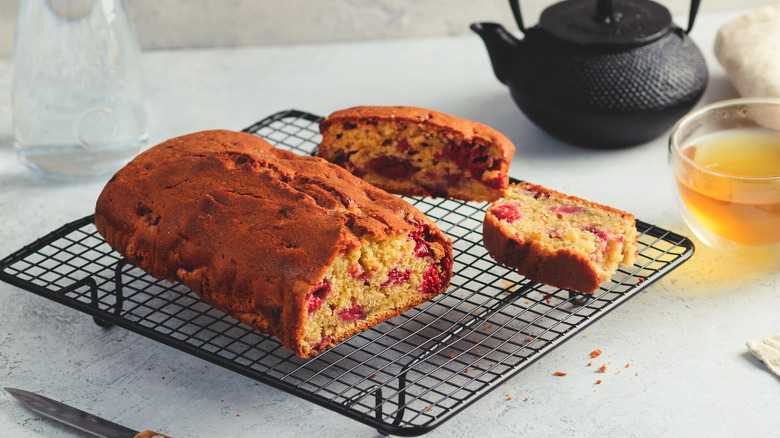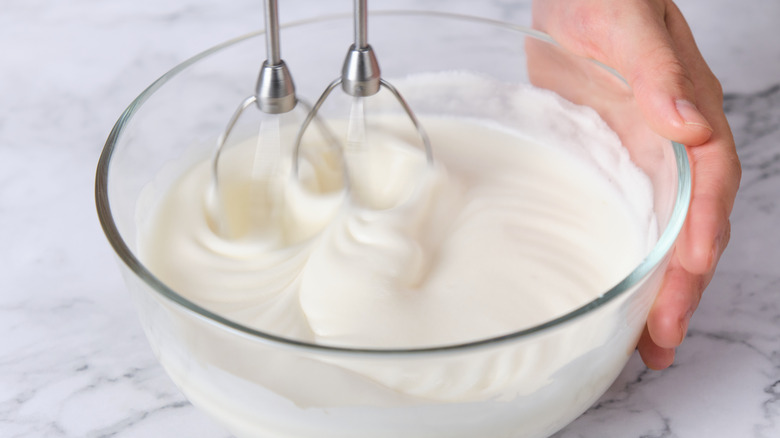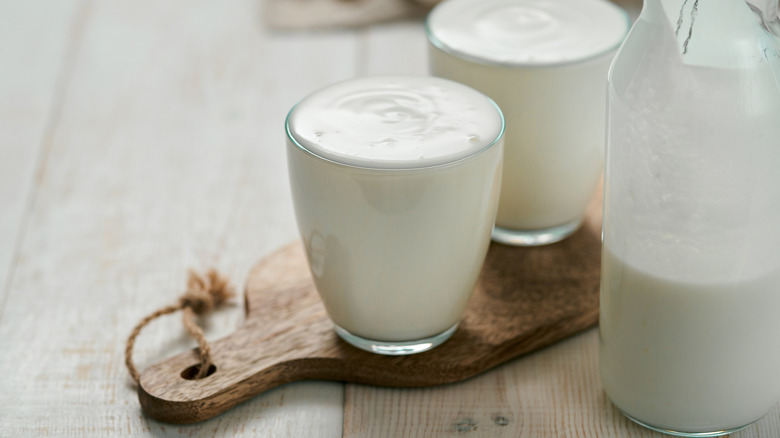11 Mistakes Everyone Makes When Making Fruit Cake
We are no strangers to the spectacle of a classic fruit cake. Nothing says holidays quite like a fruit cake — or perhaps a fruit cake joke. Despite the less than stellar reputation of this baked good, you'll be surprised to learn that it was once the reason why we all looked forward to a Christmas dinner at Aunt Ruth's place. So how did this impressive dessert go from a wintertime essential to the butt of every hacky holiday joke?
We think that the reason fruit cake is such a letdown today is that people tend to make a few grave errors when baking them. The good news is that you can still revive the old holiday tradition with a delicious, old-school fruit cake through a bit of education. By avoiding some simple errors, you can turn this vastly misunderstood dessert into something that can very well be the star of your next family get-together. Want to turn all those jokes on their head? Then get ready to learn about mistakes everyone makes when making fruit cake so you can create the best version possible.
1. Over baking your cake
No matter how much of a pro you are with baking cakes, some last-minute errors are bound to happen. You might open your own only to find that an extra minute or two in the scorching heat has dried your cake into a tough, crumbly mess.
If disaster has already struck, there may be a way to recover your fruit cake. Food Heaven suggests the microwaving method. First, place a damp paper towel on a microwave-safe plate. Then place your cake on top and microwave it at medium heat in short intervals, until you find moisture evaporating from the saturated paper towel has revitalized the cake. However, this method only works if you're serving it immediately since the moistening effect won't last long. You might also try the bread method. Place a slice of bread with your cake in a sealed packet and leave it there until the bread has turned hard. Be warned that this one takes a fair amount of time.
According to EHow, you can also give new life your fruit cake by soaking it with a liquor such as brandy or rum, or even a simple syrup. That's how this Quora user fixes a cake that has been over baked. And, of course, a little extra attention during the baking process can help stave off disaster in the first place.
2. Not pre-soaking your fruits
When it comes to making the most incredible fruit cake, the secret lies in a good' soak. According to Kitchen Seer, pre-soaking dried fruits makes them more plump, adds flavor, and keeps them from absorbing moisture from other wet ingredients in the cake batter. Soaking can also dramatically affect the texture of the final cake. Imagine slicing into your fruit cake only to find unpleasantly dry chunks of fruit.
To soak, many bakers turn to liquors like rum or bourbon, or a combination of liquor and juice, like this Reddit user. However, keep in mind that soaking dried fruits does not remove sugar from the equation. In fact, soaked fruits have more calories and sugar than non-dried ones. If you want to reduce your sugar intake, you're better off skipping the candied versions of your fruit mix-ins.
So, how long do you actually soak dried fruit for cake-based perfection? Anywhere from 24 hours to months for the especially dedicated, as Kitchen Seer reports. Typically, it takes more time when you use liquor than non-alcoholic liquids. But if you're in a hurry, soaking it overnight should also do the trick.
3. Not aging your fruit cake
There's no denying that all good things in life take time, dear bakers. The first step to making a mature fruit cake with complex flavors is soaking. According to Collin Street Bakery, you can start this process by poking holes in the cake using skewers. Then pour on your liquor of choice, such as Champagne, rum, or a brandy such as Cognac. Of course, it's always smart to measure out the liquor beforehand, lest you overdo things. And if you think you'll spill and make a mess, use a basting brush.
Next comes wrapping, which retains moisture by cutting down on the cake's contact with the air. First, Collin Street Bakery recommends wrapping the baked cake with cheesecloth, then plastic wrap, and then foil. Then, put the entire thing in an airtight box or container and keep it away from sunlight and at room temperature.
After a week of leaving the cake undisturbed, you'll need to repeat the soaking and wrapping process once again. And again, and again, repeating it all every week until you've hit three months (though you can go on for even longer if you like). This will add complexity, richness, and depth to the flavor profile of your already tasty fruit cake.
4. Overfilling your baking pan
Always read your cake recipe thoroughly. All the essential details should be there, including just how much batter goes into the pan. If by any chance a recipe omits this information, don't worry. You can reliably fill your cake pan to about ⅔ its capacity. Generally speaking, a cake pan should typically only be filled between ½ and ¾ its total size. This gives the fruit cake enough room to rise while preventing spilling and annoying oven floor cleanups.
Consider the shape of the pan, too. Whereas an 8-inch square pan readily accommodates 8 cups of batter, circular pans of 6-8 inches in diameter can typically handle up to 4-6 cups (via Kitchen Seer).
Don't think that under-filling the pan will save you, either. If you don't pour enough batter into your cake pan, the cake won't be fluffy. Instead, chances are that it'll be disappointingly flat. It might taste fine (though over-baking is always a possibility here), but it won't look good. So, always read the recipe and make sure to always fill your pan as per the directions.
5. Using cold ingredients
Cold ingredients make for a bad fruit cake. There's no rocket science behind this but some simple-dimple common sense. As per one Redditor, the short answer is that the temperature impacts how well the ingredients combine. Take a look at butter, for instance. Cold butter is terrible at incorporating into the mixture, resulting in a clumpy mess instead of a smooth batter.
Sally's Baking Addiction notes that a smooth batter equals a uniformly textured baked good. Eggs, butter, and other dairy ingredients form an emulsion with air trapped inside. This air expands when exposed to heat in the oven, giving you a fluffy cake.
Cold butter is unlikely to cream appropriately with sugar and so won't give you the fluffy cake you were hoping for. To make your butter come to room temperature quickly, you can place it near a heat source, like a stove. You can also gently microwave it, but be careful not to melt or burn your butter. Meanwhile, eggs often need to be beaten and whisked into cakes, which is much easier to do when they're at room temperature. That's because eggs also trap air bubbles that rise in the oven to give you soft, fluffy fruit cake. Room temperature eggs tend to aerate better than cold ones.
6. Not coating your fruits and nuts first
Sometimes you've got everything down to a science, following the recipe exactly to bake the most perfect, moist fruit cake. But when you slice into the thing, you see that your dried fruit has sunk to the bottom. "Disappointed" doesn't even begin to describe the range of negative emotions you are likely to feel in that moment.
To avoid this sad spectacle, all you have to do is coat your fruits and nuts in flour. Whether you have used dried fruits or a candied version, you need to toss them with a little bit of flour in a small bowl before adding them to the cake batter. Baking Mad further notes that if you're using glace cherries or other large pieces of fruit, you should first cut them into smaller sizes before coating. Larger, heavier chunks are more likely to sink to the bottom of your batter.
One Reddit user also argues that coating mix-ins with flour is necessary because the gluten in the flour acts like a kind of edible glue that keeps fruit and nuts from sinking. Plus, it helps absorb liquid and does not discolor the batter. When possible, you should use flour from the recipe instead of a large amount of additional flour, as that may affect the texture of your cake.
7. Not measuring your ingredients properly
If you're heavy-handed when adding ingredients to the mix, then you're simply setting yourself up for disaster. The culinary world calls for rules, which are especially important to follow when measuring. A little more or a little less, and your little fruit cake experiment will (figuratively, hopefully not literally) blow up in your face. Even professional bakers need to slow down and reach for the measuring tools. The same rule naturally applies to home chefs as well.
For instance, what would happen if you added too much flour and fewer eggs and butter to your fruit cake? The dry, crumbly, floury mixture won't even bother to rise and will probably say, "don't bother putting me in the oven."
According to The Bake School, it doesn't matter which unit of measurement you use, whether cups, ounces, or milliliters. What matters is measuring correctly. For liquid measurements, use liquid measuring cups, which are designed so you can pour from them. Make sure you level the liquid volume by placing it on a flat surface like a countertop. Similarly, use a dry measuring cup for measuring dry ingredients like flour and sugar. Better yet, use a kitchen scale to get the most accurate results of all.
8. Not letting fruit cake cool on a rack
If your fruit cake is coming out wet from the pan, then we have a magical apparatus for you called the "cooling rack." This versatile piece of equipment can make a big difference. When your fruit cake has cooled down, as this Quora user suggests, turn it over and place it on the rack. This will ensure that your cake is evenly cooled from all sides, as the open structure will help air circulate around the bottom of the cake. This help prevent issues with the dreaded soggy bottom.
Another Quora user says that if your cake is still wet, chances are you left it in the pan for too long. The best thing to do is practice some prevention. Line your pan with parchment paper before pouring in the batter. Then, when the cake is done, test it for Donnie's before taking it out. If you're satisfied, let it cool for 10 minutes and then transfer to a wire rack.
Sometimes the middle of the cake remains wet and uncooked. This may be because you've baked your cake at too low of a temperature or you've taken it out of the oven too soon. If that's the case, you might be able to pop it back in the oven until your cake is perfectly cooked (via Cake Decorist).
9. Over mixing the cake batter
Sometimes, we're so enthusiastic about getting our batter to the perfect consistency that we tend to overdo it when combining all of our ingredients. But what's so bad about that? Practically everything. That's because overmixing batter often leads to drastic results, like too much gluten development that creates overly tough cakes. You simply need to mix until your wet and dry ingredients are perfectly combined and incorporated. One Quora user suggests stirring only until everything's blended into a cohesive whole.
A professional chef on Quora says that when you mix too much, you end up tangling the long threads of gluten, a protein that develops in a flour-based batter. That in turn makes for a hard crust and will prevent your fruit cake from rising. Moreover, though you should aerate the batter, when you exceed the mixing limit, you end up knocking open air bubbles and creating an inconsistent rise. The resulting cake will be lumpy and have an unpleasantly inconsistent texture. According to Foods Guy, overmixing the batter also makes for a crumbly cake.
10. Opening the oven door too often
Curious? Impatient? Don't let that tempt you to open the oven door every few minutes. We know that sometimes you really want to know how well the cake is baking, how long it will take in the oven, or simply just to see if it has risen. But that could lead to the utter ruin of your fruit cake. For starters, you're letting all the heat escape. Now the oven has to work to get itself back to temperature. Opening the oven door too frequently will cause the temperature inside to fluctuate, deflating your perfect fruit cake and affecting its final texture.
Moreover, you're simply extending the baking time the more you open the door. Moreover, Betty Crocker notes that the hit of cold air you're inflicting on the oven when you take a peek can also lead to cake collapse. While it is not entirely forbidden to do so, you should only open the door once or twice when your fruit cake is almost done baking.
11. Using too few wet ingredients
Too few moist ingredients in your batter can lead to a disappointing, crumbly fruit cake that falls apart like sand in your hand. But what are the best wet ingredients to use when it comes to fruit cake? As Oven Via notes, you can add a cup of applesauce to the batter so that it gets to the right consistency and yields a fluffy, moist fruit cake with great taste. You can also keep a pan of water under the baking rack, which can increase the humidity in your oven.
Meanwhile, Baking Like A Chef suggests incorporating buttermilk. The acid in buttermilk helps to break down gluten and gives the cake a slight tang that compliments its sweet, fruity nature.
You might also swap out vegetable oil for butter. Since oil remains in a liquid state through a wider range of temperatures (compared to butter, which tends to solidify at room temperature), oil can help cakes stay soft and moist in a few different environments. According to Baking Like A Chef, you can replace oil at 80% of the volume of butter. For instance, if a recipe calls for 100 grams of butter, you could potentially use 80 grams of oil in its stead.











